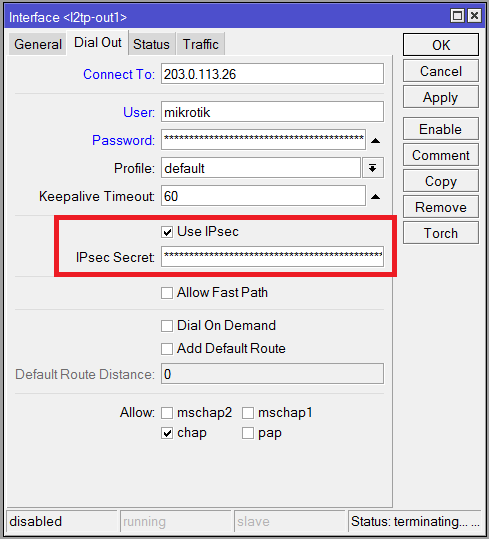

Fortunately, IPsec configuration on MikroTik is trivial.

This interconnection via the L2TP tunnel was just plain ol’ L2TP, without IPsec. Once OSPF was working as expected, I remove the static routes. I added an additional area on both ends, for the future VPN networks. Networks behind the tunnel endpoints were routed with static routers, so I configured a quick multi-area OSPF routing system, with the directly connected networks on area 0, along with the /30 network of the tunnel. Over the Proxmox hypervisor, they also had a MikroTik CHR instance, with a P1 license, which was used to make a L2TP tunnel to a RB2011UiAS-rm located on their HQ. This solution, which I considered not elegant, was the only available at the moment due to networking constraints of the VPS provider, so really it was the best they were able to do, and it worked fine for them. I guess we all know having internet-exposed RDP is not a good idea, even if it is running in a non default port, so the former sysadmin transitioned to a SSH tunnel system, where the users connected to the hypervisor via SSH to establish tunnel to the desired server.
L2TP WITH IPSEC ON MIKROTIK ROUTEROS WINDOWS
Proxmox was also using iptables on its the Debian backend of the to masquerade the VM networks with a public IP address, for Internet connectivity, dstnat rules for a NGINX reverse proxy, and RDP for the Windows servers. There was a Proxmox hypervisor, with some Windows 2012 R2 servers, providing Terminal Services, to execute a locally installed client for an ERP system. I have started a gig as a consultant and sysadmin for a logistics insurance company, and one of my first proposals was to improve the network access for road warriors and remote workers. RouterOS VPN portfolio 10 PPPoE -Point-to-Point Protocol over Ethernet PPTP Point to Point Tunneling Protocol L2TP -Layer 2 Tunneling Protocol SSTP Secure Socket Tunneling Protocol OVPN Open Source VPN IPSEC -Internet Protocol Security EoIPEthernet over IP MUM Europe,Ljubljana2016.03.25 Andis Arins / router. Moving even further, a single router could provide VPN access and dynamic routing to integrate remote networks to the backbone. Both comments and pings are currently closed. With the advance of cheap MikroTik routers and ready to use CHR instances, setting up a VPN concentrator for remote access has become an easy task. Tags: Alsacecom, Mikrotik, routerOS, VPN This entry was posted on jeudi, mai 24th, 2012 at 14:36 and is filed under Mikrotik, VPN.You can follow any responses to this entry through the RSS 2.0 feed.


 0 kommentar(er)
0 kommentar(er)
